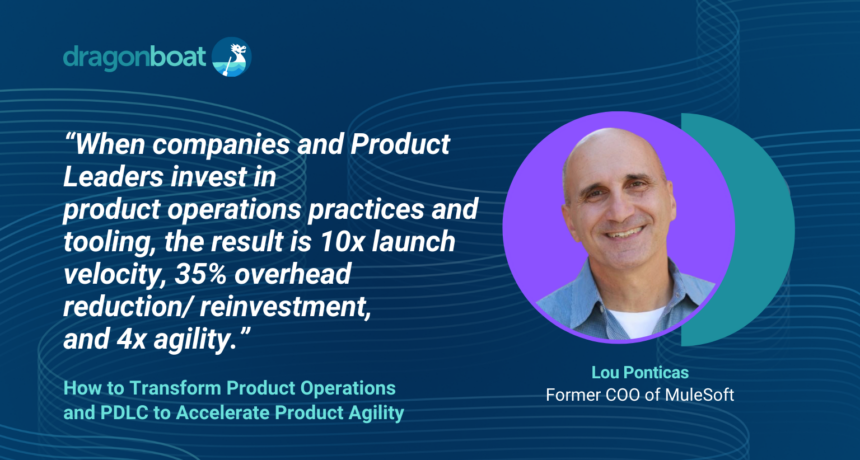Why Product Operating Model Transformation?
To Accelerate Product Delivery and Capture Market Opportunity.
In the early 2000s, PayPal saw a massive global market opportunity. But as the business expanded and product and engineering teams grew, its ability to launch products internationally slowed dramatically. What followed was a major product operating model transformation—paired with an agile development shift—that reshaped how PayPal built and shipped products.
The impact was enormous: PayPal went from launching fewer than two products a year in international markets to more than 100 launches annually, with especially strong growth across regions like APAC.
At Dragonboat’s Accelerate 2023 virtual summit, Lou Ponticas, former Head of Product Ops and Lead for the Product Center of Excellence at PayPal, shared how the company transformed its product operating model in 2011. The shift moved PayPal from a loosely connected, organically grown structure to an integrated model designed for agility at scale.
Looking back, the transformation had both immediate and lasting effects. This product operating model transformation centered around three main areas: people, ways of working, and tools.
The Challenge
Before its transformation, PayPal’s product organization has become highly fragmented from years of rapid growth. Nine independent organizations worked in silos, leading to incongruent customer experiences, duplication of efforts, and low morale as external factors like last-minute business development deals and requests from PayPal’s parent company at the time, Ebay Inc, frequently disrupted roadmaps.
We had over 60 onboarding experiences, which created confusing customer experiences and were also costly to maintain.
– Lou Ponticas
These issues were compounded by:
- An org structure comprised of independently operating/ siloed teams that led to duplication of work and challenges with coordination.
- Operating processes that were inconsistent across regions, slowing product delivery.
- A disconnected tool stack made it difficult to coordinate roadmaps, manage dependencies, and monitor and address delivery risks.
This decentralized / disconnected product operating model limited PayPal’s ability to innovate, scale globally, and respond to market demands. Addressing it was essential to a turnaround.
A key change mirrored McKinsey’s recommendation in the five actions to get the transformation right: “Build product teams around the end-user experience.” Without the proper infrastructure in place, failure looms.
Transforming Through People, Process, and Tools
The solution to these challenges was a comprehensive transformation of PayPal’s product operating model, with a focus on aligning people, streamlining processes, and integrating tools.
People: Aligning Teams for Global Collaboration
At the heart of PayPal’s transformation was the reorganization of its product teams into a centralized global product organization. This shift from nine independent teams to a unified structure allowed for better alignment and collaboration across regions.
Key changes in people included:
- Core and Solution Product Managers: PayPal introduced two key roles—Core Product Managers, who were responsible for flagship products like checkout and credit, and Solution Product Managers, who were embedded in regional markets (North America, APAC, EMEA). Solution Product Managers ensured that global products were adapted to meet local customer needs, while the Core Product Managers maintained consistency and oversight at the global level.
- Customer-Driven Innovation (CDI): By adopting CDI, a methodology combining Design Thinking, Lean, and Agile principles, PayPal ensured that customer insights from all markets were incorporated into product development. This approach allowed regional teams to innovate locally while remaining aligned with global objectives.
This people-centric alignment enabled PayPal to leverage local expertise while maintaining global consistency, fostering greater collaboration and efficiency.
Process: Streamlining the Product Development Lifecycle (PDLC)
To eliminate inefficiencies and enable faster product delivery, PayPal standardized its processes by introducing an Agile-based Product Development Lifecycle (PDLC). This new process allowed for more responsive and coordinated product development across all teams.
The process changes included:
- Quarterly planning cycles: Moving from an annual to a quarterly planning cycle allowed PayPal to be more agile and responsive to market shifts. This change enabled product teams to adjust roadmaps quickly, reducing the frustration of long, rigid planning processes.
- Cross-functional disruption management: A formal process was introduced to manage external disruptions, such as last-minute requests from eBay or business development deals. By engaging these disruptors earlier in the planning process, PayPal minimized last-minute changes that previously derailed product roadmaps.
- Integrated global-local product management: The new PDLC ensured that core product teams in the US worked closely with solution managers in regional markets. This integration allowed for more effective localization of products, ensuring global products were adapted to meet specific market needs without duplicating efforts.
By streamlining processes, PayPal created a more cohesive and agile product development framework that enabled faster decision-making and product launches.
Tools: Integrating Portfolio Management for Faster Visibility and Better Decisions
The foundational pillar of PayPal’s product transformation was implementing integrated tools and a connected data layer to provide real-time visibility across the PDLC. PayPal introduced Rally for development tracking and a predecessor of the Dragonboat platform for product portfolio management.
Key tooling improvements included:
- Consolidated portfolio management: A single system (Dragonboat) for planning and tracking, eliminating the confusion, fragmented or outdated data from disconnected tools.
- On-demand planning and adjustments: The new toolset allowed PayPal to support on-demand planning, enabling teams to respond quickly to new opportunities or market changes without disrupting the overall product roadmap.
- Data-driven decision-making: With a unified toolset in place, PayPal’s leadership had access to real-time data on product development, allowing them to make faster, more informed decisions. This helped align teams across regions and reduced the friction caused by misaligned efforts.
By integrating the right tools, PayPal ensured that its product operations were transparent, efficient, and data-driven, further enhancing the agility of its teams.
The Impact of an Integrated People-Process-Tool Approach
The transformation of PayPal’s product operating model profoundly impacted its ability to innovate and scale globally. Key results included:
- Increased product launch velocity: PayPal went from launching fewer than two products in international markets annually to over 100 product launches each year, with significant growth in regions like APAC.
- Improved efficiency and reduced headcount: By eliminating redundancies and streamlining processes, PayPal reduced operational expenditures by 30% while still improving productivity.
- Faster, more responsive planning: The shift to quarterly planning cycles and the integration of new tools enabled PayPal to respond quickly to market changes, making product roadmaps more dynamic and adaptable.
When companies and Product Leaders invest in Product Operations practices and tooling, the result is 10x launch velocity, 35% overhead reduction/ reinvestment, and 4x agility.
– Lou Ponticas
Key Takeaways for Digital and Product Transformation Leaders
- Organizational structure: By forming product teams around the end-user experience and defining clear roles for core and solution managers, PayPal eliminated silos and improved collaboration across global and regional teams.
- Adopt outcome-focused product management: Expanding the software development lifecycle (SDLC) to apply a customer-centric product development lifecycle (PDLC) and adopting an outcome-focused product portfolio management practice helped PayPal accelerate product delivery and respond quickly to market changes.
- Unified tools improve visibility and decision-making: the right tool enables the right practice, and data needed for decisions. Integrating a portfolio management system provided PayPal with the insights needed to prioritize holistically, gain visibility, monitor progress, and make trade-off decisions.
PayPal’s product operating model transformation highlights the importance of aligning people, streamlining ways of working, and integrating tools with data to achieve product operating agility and scalability. By addressing these three pillars, digital transformation leaders can eliminate inefficiencies, foster collaboration, and drive faster, more impactful product launches, positioning their organizations for long-term success.
Ready to accelerate your transformation journey?
Dragonboat brings your product operating model and data to life—making it possible to roll out changes faster, drive real adoption, and adjust your model easily as your business evolves. No more relying on decks or spreadsheets that teams can’t act on.
Talk to our product expert today!



